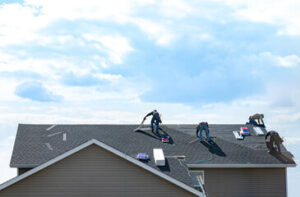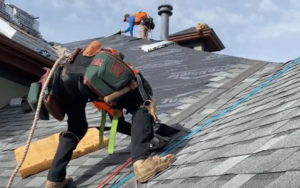A well-constructed roof is more than just a shield against the elements. It enhances structural integrity and energy efficiency. The demand for innovative roofing solutions has led to remarkable advancements. Homeowners and businesses now seek materials that offer durability and sustainability.

Modern roofing systems incorporate technology to improve functionality. Smart coatings regulate temperature and reduce energy costs. Lightweight materials provide strength without compromising design. Innovations continue to redefine how roofs contribute to overall building performance. Contact Roofing Company Antioch TN for professional help.
Sustainability plays a crucial role in roofing advancements. Recyclable materials reduce environmental impact while maintaining resilience. Energy-efficient designs help minimize heat absorption and cooling expenses. The shift toward eco-friendly solutions reshapes the industry’s direction.
Customization has become a priority in roofing projects. Clients expect options that align with aesthetic preferences and practical needs. Color retention technology ensures long-lasting visual appeal. Flexible materials allow for unique architectural designs without sacrificing protection.
Advanced weatherproofing techniques increase roof longevity. Water-resistant membranes prevent leaks and structural damage. Impact-resistant materials offer protection against extreme conditions. These innovations provide long-term cost savings and reliability.
Maintenance solutions have evolved to simplify upkeep. Self-cleaning coatings prevent dirt buildup and reduce maintenance efforts. Digital monitoring systems detect issues before they escalate. Property owners benefit from proactive solutions that extend roof lifespan.
The installation process has also improved for efficiency. Modern tools enhance precision and reduce project duration. Prefabricated components streamline construction and minimize waste. Roofing companies now prioritize speed without compromising quality.
The role of insulation in roofing has expanded significantly. High-performance materials regulate indoor temperatures more effectively. Proper insulation reduces energy consumption and improves overall comfort. This evolution aligns with the growing demand for energy-conscious solutions.
Storm-resistant roofing solutions are gaining popularity. Reinforced designs withstand harsh conditions without frequent repairs. Wind-resistant structures prevent uplift and maintain stability. Advanced fastening systems add extra security against extreme weather.
Fire-resistant roofing materials contribute to overall safety. Flame-retardant coatings provide an extra layer of protection. Non-combustible components reduce risks in fire-prone areas. These advancements offer peace of mind for property owners.
Aesthetic trends in roofing continue to evolve. Sleek, minimalist styles complement modern architectural designs. Natural textures create a rustic appeal while maintaining durability. The fusion of aesthetics and function elevates roofing beyond mere utility.
Smart roofing technology is transforming the industry. Solar-integrated roofs provide renewable energy solutions. Sensors detect leaks and alert owners to potential issues. Automation enhances convenience and long-term cost-effectiveness.
Acoustic insulation is becoming a sought-after feature. Soundproof materials reduce noise pollution in urban settings. Enhanced insulation creates a quieter and more comfortable indoor environment. This innovation addresses growing concerns about external disturbances.
Lightweight roofing solutions redefine structural possibilities. High-strength materials ensure durability without excessive weight. Reduced structural load increases design flexibility. These developments open new opportunities for architectural creativity.
Cool roofing technology enhances energy efficiency. Reflective surfaces reduce heat absorption and cooling costs. Heat-dissipating materials maintain indoor comfort. This advancement aligns with the need for sustainable living spaces.
The rise of modular roofing systems is changing installations. Prefabricated panels simplify assembly and reduce labor expenses. Precision manufacturing ensures consistent quality. This approach enhances efficiency while maintaining performance standards.
Water collection systems are integrated into roofing designs. Built-in drainage solutions optimize rainwater harvesting. Sustainable practices promote resource conservation and eco-friendly living. These innovations contribute to responsible construction approaches.
Roofing companies focus on long-term value rather than temporary fixes. Comprehensive warranties provide confidence in material longevity. Preventative maintenance programs enhance durability and cost-effectiveness. Quality craftsmanship remains a top priority in modern projects.
Technological advancements continue to shape the roofing landscape. Artificial intelligence assists in predictive maintenance and damage assessments. Digital modeling enhances design accuracy before installation begins. The industry embraces cutting-edge solutions for improved efficiency.
Training and skill development play a crucial role in roofing excellence. Professional expertise ensures flawless installations and long-lasting performance. Safety protocols evolve to protect workers and clients alike. The demand for highly skilled specialists continues to grow.
The intersection of roofing and renewable energy creates new possibilities. Solar-ready designs maximize sustainability without aesthetic compromise. Energy-efficient roofing materials contribute to lower carbon footprints. This evolution marks a significant shift toward responsible construction.
With ongoing research and development, roofing solutions will continue to advance. Emerging materials enhance durability while prioritizing environmental consciousness. The fusion of science, technology, and craftsmanship drives industry progress. The future of roofing is defined by innovation and resilience.
Hybrid roofing materials are gaining attention in modern construction. The combination of synthetic and natural components improves durability. These advanced solutions enhance longevity while remaining cost-efficient. Hybrid options offer an ideal balance between function and sustainability.
Robotic technology is revolutionizing roof installations. Automated systems ensure precision and reduce manual labor risks. Drones assist in inspections, identifying issues with greater accuracy. These innovations streamline processes while improving overall project safety.
Ventilation strategies are improving indoor air quality. Modern roofing designs incorporate airflow management to prevent heat buildup. Proper ventilation reduces moisture accumulation and prevents mold growth. This contributes to a healthier living environment.
Advanced coatings are enhancing roof durability. UV-resistant materials protect surfaces from sun damage and discoloration. Anti-corrosion treatments extend the lifespan of metal components. These developments ensure roofs remain in optimal condition for years.
Green roofing solutions are reshaping urban landscapes. Living roofs incorporate vegetation for natural insulation and air purification. These eco-friendly structures contribute to biodiversity and temperature regulation. The rise of green roofing highlights the push toward sustainable architecture.
Wind energy integration is expanding within roofing solutions. Small turbines harness natural airflow for supplemental power. These systems reduce reliance on traditional energy sources. Combining wind and solar technology enhances overall efficiency.
Reflective technology is making roofing materials more energy-efficient. Heat-reflecting surfaces reduce thermal absorption in hot climates. Lighter-colored materials improve indoor cooling without increasing costs. These improvements align with the push for climate-responsive designs.
Stormwater management features are becoming standard in roofing. Permeable surfaces help control water runoff and prevent flooding. Smart drainage systems regulate water flow efficiently. This advancement supports sustainable urban development efforts.
Modular roofing repairs are improving efficiency in maintenance. Interchangeable panels allow quick replacements without major disruptions. Prefabricated components simplify repairs and reduce costs. This modular approach ensures faster and more precise solutions.
High-performance adhesives enhance roof strength and durability. Advanced bonding agents improve material cohesion under extreme conditions. These solutions prevent leaks and structural weaknesses. Adhesive innovations continue to refine construction practices.
Weather-adaptive roofing materials adjust to changing climates. Shape-memory polymers respond to temperature fluctuations. These smart materials optimize insulation based on environmental conditions. Adaptable solutions improve efficiency in varying weather patterns.
Hail-resistant materials provide enhanced impact protection. Reinforced surfaces minimize damage from extreme weather events. These materials reduce repair frequency and maintenance costs. Advancements in impact resistance increase overall reliability.
The role of artificial intelligence in roofing is expanding. Predictive analytics help detect vulnerabilities before visible damage occurs. Machine learning improves the accuracy of repair assessments. AI-driven diagnostics streamline maintenance strategies.
Augmented reality is changing how roofing projects are visualized. Digital overlays allow real-time design previews before installations. Virtual modeling enhances decision-making and reduces errors. This technology improves project planning and execution.
Roofing materials are being developed with self-repairing properties. Advanced polymers can heal minor cracks without intervention. These innovations extend lifespan and reduce maintenance needs. Self-repairing surfaces are redefining long-term durability.
Antimicrobial treatments are being incorporated into roofing designs. Coatings prevent bacterial growth and improve hygiene in humid conditions. These features help maintain cleaner surfaces over time. The integration of antimicrobial properties enhances material longevity.
Fire-resistant roofing continues to evolve with advanced composites. Cutting-edge formulations improve heat resistance under extreme temperatures. These materials reduce fire-related risks in residential and commercial structures. Innovations in fire protection enhance overall safety.
As research advances, roofing solutions will keep evolving. The fusion of sustainable materials and smart technology reshapes industry standards. Future developments will prioritize energy efficiency and resilience. Roofing innovations continue to set new benchmarks for modern construction.
